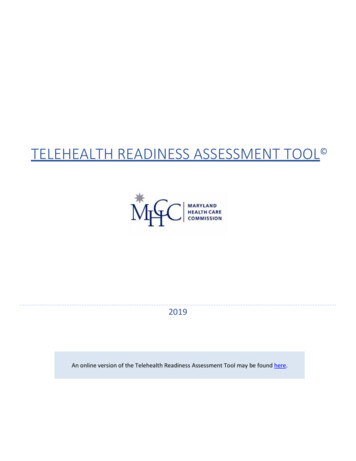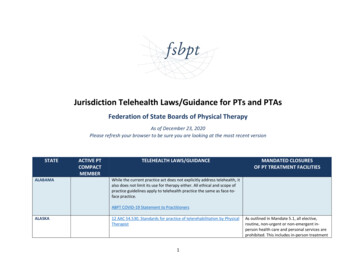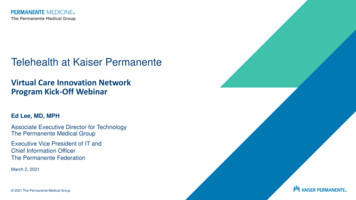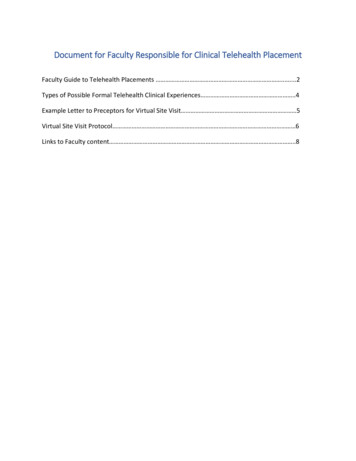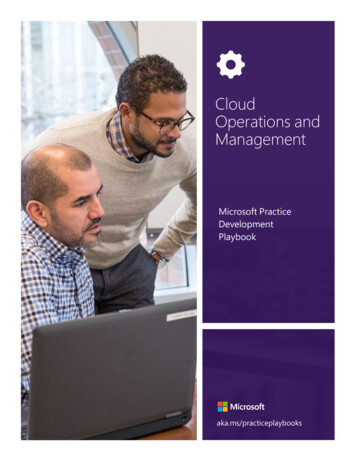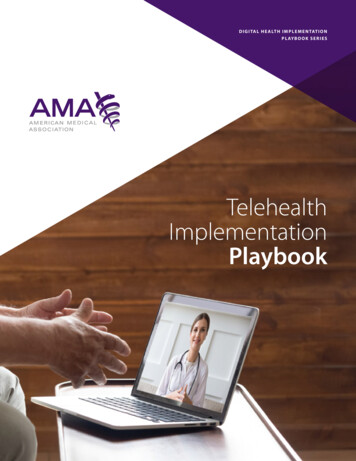
Transcription
D I G I TA L H E A LT H I M P L E M E N TAT I O NP L AY B O O K S E R I E STelehealthImplementationPlaybook
AMERICAN MEDICAL ASSOCIATION TELEHEALTH IMPLEMENTATION PLAYBOOKT H I S A M A T E L E H E A LT H I M P L E M E N TAT I O N P L AY B O O Kis for informational purposes only. It is not intended as medical, legal, financial, or consultingadvice, or as a substitute for the advice of a physician, attorney, or other financial or consultingprofessional. It does not imply and is not intended as a promotion or endorsement by the AMAof any third-party organization, product, drug, or service. The opinions expressed by individualsin this Playbook represent the views of the individuals themselves and not those of the AMA.Reimbursement-related information provided by the AMA and contained within this Playbookis for medical coding guidance purposes only. It does not (i) supersede or replace the AMA’sCurrent Procedural Terminology (CPT ) manual (“CPT Manual”) or other coding authority,(ii) constitute clinical advice, (iii) address or dictate payer coverage or reimbursementpolicy, and (iv) substitute for the professional judgment of the practitionerperforming a procedure who remains responsible for correct coding.CPT Copyright 2022 American Medical Association. All rights reserved. AMAand CPT are registered trademarks of the American Medical Association(more information can be found here). 2022 American Medical Associationhttps://www.ama-assn.org/terms-use
Table of ContentsPART 1 / WARM-UP6Introduction to the Digital Health Implementation Playbook8Introduction to Digital Health Solutions9What is Telehealth?10Telehealth in PracticeContinuity of CareLicensureReimbursement13131415The Path to Implementation16PART 2 / PRE-GAME18Step 1 / Identifying a Need20Step 2 / Forming the Team24Step 3 / Defining Success28Step 4 / Evaluating the Vendor32Step 5 / Making the Case38Step 6 / Contracting42PART 3 / GAME TIME – TELEHEALTH46Step 7 / Designing the Workflow48Step 8 / Preparing the Care Team54Step 9 / Partnering with the Patient58Step 10 / Implementing64Step 11 / Evaluating Success68Step 12 / Scaling72PART 4 / POST-GAME – RESOURCES78
4
“With the evolving COVID-19 pandemic and its impact on access to medical care, thereis no better time to help physicians navigate and implement telemedicine into theirpractices and enhance their ability to care for patients. Through telemedicine, we cantriage patients and help avoid unnecessary visits to health care settings, therebyreducing exposure to the COVID-19 virus and helping to keep our front linessafe, ensuring they have the resources needed to take on this immensechallenge. The tools and guidelines being created now arealready helping many to use telemedicine and willcontinue to help define its role at this moment,and shape the future of physician practice.”— D R . R U S S E L L L I B BY,P E D I AT R I C I A N & B O A R D M E M B E R ,P H YS I C I A N S F O U N D AT I O NTelehealth & COVID-19It is of paramountimportance to keepphysicians, health careworkers, and patientssafe amid infectiousdisease outbreaks such asthe COVID-19 pandemic.Telehealth has supported physicaldistancing efforts and helped toensure that care continues to beprovided to those who need itmost by triaging low-risk urgentcare and follow-up appointmentswhile maintaining continuity of care,especially for chronic disease andbehavioral health patients who mayrequire routine check-ins.By reducing unnecessary visitsto health care environments, wecan curb the exposure to andtransmission of infectious disease,while helping to keep our frontlines safe and ensure they have theresources needed to take on thisimmense challenge. Telehealth hasbeen particularly crucial throughoutthe current pandemic.The American Medical Associationis committed to supporting andadvocating for physicians andpractices throughout the COVID-19pandemic. For the latest informationand updates on COVID-19 and theAMA’s physician resources, visit theCOVID-19 Resource Centerfor Physicians.In addition to this resource, ifyou are working to optimize andsustain telehealth in your practice,the American Medical Associationalso recommends visiting the AMATelehealth Quick Guide resourceand accessing the AMA STEPSForward Innovation AcademyTelehealth Immersion Program.5
Part 1:Warm-upBefore you embark on yourtelehealth implementation,it’s important to understandwhat telehealth is and how it’simpacting the world of health care.In this section of the Playbook,we’ll define telehealth and explainhow to use the resources includedin this document.6
7
PA R T 1 / WA R M - U PIntroduction to the Digital HealthImplementation PlaybookDigital tools that enable new methods and modalities to improve health care,enable lifestyle change, and create efficiencies are proliferating quickly. Clinicalintegration of these tools is lacking. We want to change that.At the AMA, we are committedto partnering with physicians tomeet the changing landscapeof health care. Recent research1found that physicians had four keyrequirements for the adoption ofdigital health in practice: Does it work?Will I receive payment?Will I be liable?Will it work in my practice?In support of that pursuit, we havecollaborated2 with physicians,care team members, patients, andthought leaders to create theDigital Health3 ImplementationPlaybook Series.W H AT I S A D I G I TA L H E A LT HI M P L E M E N TAT I O N P L AY B O O K ?Months of research compiled intoa Playbook documenting the mostefficient path to implementinga new digital health solution,including key steps, best practices,and resources to accelerate andachieve digital health adoption.8W H O I S T H I S P L AY B O O K S E R I E S F O R ?This series is intended for thosewho believe in the importance ofdigital health and its role in helpingdeliver better care. Whether you area physician, a care team member,a health care administrator, ora passionate advocate for theimplementation of digital healthtechnology, if you are looking forguidance to navigate the process andachieve scale, this series of Playbooksis for you.W H Y S H O U L D I U S E T H E P L AY B O O K S ?Implementing digital healthtechnology can be complicatedand time-consuming. On average,it takes hospitals 23 months to gofrom identifying a digital innovationneed to scaling a digital solutionto meet that need4. The Playbookseries has been designed with inputfrom over 140 physicians, care teammembers, health care administrators,and digital health thought leaders tohelp health care organizations adoptchange faster and more successfully.WHEN SHOULD I USE THEP L AY B O O K S E R I E S ?Refer to this series of Playbookswhenever you are consideringthe implementation of a digitalhealth solution. By adopting thesesolutions now, your organizationcan improve its ability to deliver onthe Quadruple Aim of Healthcare,inclusive of Health Equity5.WHERE CAN I USE THEP L AY B O O K S E R I E S ?The Playbooks are designed for careteams and administrators in medicalpractices of all sizes and areas ofspecialty. We have consulted withsmall private practices and largehealth systems, in rural and urbansettings, with high-income andMedicaid-dependent populations.No matter where you are, youcan use this Playbook as a guideto successfully implement digitalhealth solutions in your practice.
Introductionto DigitalHealthSolutionsNew technologies arefundamentally changing the waypeople interact with health care.Successful implementation ofdigital health technology will beimperative for improving patientoutcomes and ensuring financialstability for health care practices.but report that knowledge gainedby other organizations and bestpractices is not readily available.This Playbook series is an effortto provide widespread access toinstitutional knowledge and bestpractices currently held by expertsin the field.The landscape of digital healthtechnology is seemingly endlessand spans from clinical workflowsolutions and data managementto population health and patientinteraction tools. You’ve likelybeen exposed to or consideredimplementing a number ofthese solutions.The Playbook series will be updatedto include new content over time.As the series evolves, it will providehelpful frameworks and resourcesfor your practice related to specificdigital health solutions.Despite the increasing prevalence ofdigital health, many health systemleaders struggle to drive innovationin their organizations. They arelooking for a better, more efficientpath to scaled implementation,This Playbook providesresources for theimplementation of:TelehealthIf you are currently interestedin learning more abouttelehealth, you can findmore resources th-resource-centerama-policy-resources.If you are interested inlearning more aboutimplementing digital healthsolutions, you can find otherPlaybooks in the Series atama-assn.org/digital-healthplaybook.9
PA R T 1 / WA R M - U PIntroduction to TelehealthFor the purposes of this Playbook, we define telehealth as a digital health solutionthat connects the patient and clinician through real-time audio and videotechnology. It can be used as an alternative to traditional in-person care deliveryand, in certain circumstances, can be used to deliver care such as the diagnosis,consultation, treatment, education, care management, and self-managementof patients.WHAT IS TELEHEALTH?Telehealth, telemedicine and relatedterms generally refer to the exchange of medicalinformation from one site to another through electroniccommunication. The Centers for Medicare and Medicaid Services(CMS) defines telehealth as a two-way, real-time interactive communicationbetween a patient and a physician or practitioner at a distant site throughtelecommunications equipment that includes, at a minimum, audio andvisual equipment.While telemedicine has historically eferred to remote clinical services,telehealth can refer to broader services including:Synchronous TelehealthAsynchronous Telehealth Real-time, audio-video communication that connectsphysicians and patients in different locations. Note:This definition is used for telehealth for CMS coverageand payment. Store-and-forward technologies that collect imagesand data to be transmitted and interpreted later. Real-time audio and telephone communications. Online digital visits and/or brief check-in servicesfurnished using communication technology that areemployed to evaluate whether or not an office visit iswarranted (via patient portal, smartphone). Interprofessional internet consultations betweenphysicians and/or other qualified health careprofessionals to improve care coordination for patientsby sharing verbal or written reports for furtherassessment and/or care management.10
COMMON USES FOR TELEHEALTH INCLUDE:F O L LO W - U P C A R EB E H AV I O R A L H E A LT H Patients on treatmentprotocols who need closefollow-up care and multiplevisits to ensure complianceand manage medication Care for chronic and complexconditions, including virtualconsults on lab results,symptom triage, lifestylemanagement, andremote patient monitoring(RPM) check-ins Post-operative wound care Group education consultswith prediabetic and diabeticpatients on healthy eating,exercise, and wellness tips Address shortages in local oron-site mental health servicesin rural or underservedpopulations by connectingpatients to a specialist8 For routine follow-ups withanxiety, depression, andADHD patients who areadjusting to new medications Routine virtualpsychotherapy appointmentsO V E R CO M I N GT R A N S P O R TAT I O N B A R R I E R S Access care from theconvenience of thepatient’s home For patients who face mobilitybarriers and lack a caregiver orassistance with transportationto the doctor’s office Urgent care for establishedpatients with low-risk,infectious diseases, such asconjunctivitis or urinarytract infection For long-term patients whoare temporarily relocated outof state Pre-orthopedic surgerypreparation Expand access to andexpedite clinical trialsBENEFITS OF TELEHEALTHTelehealth adoption allows health care providers toincrease continuity of care, extend access beyond normalclinic hours, reduce patient travel burden, and helpovercome clinician shortages, especially in rural and otherunderserved populations6, which ultimately helps healthsystems and physician practices focus more on chronicdisease management, enhance patient wellness, improveefficiency, provide higher quality of care, and increasepatient satisfaction7. It can also be used to help reduce thespread of infectious diseases.BARRIERS TO TELEHEALTHAlthough telehealth brings many benefits, we alsorecognize the barriers to adopting such technology,including inconsistent reimbursement models9;interstate licensure challenges10; legal and regulatoryissues11; concerns over security, privacy, andconfidentiality12; lack of evidence about impact on healthcare costs, utilization, or outcomes13; concerns aboutimpacts to clinical duty to provide safe and effectivecare (e.g., over-prescribing antibiotics in urgent caresettings)14; and logistical space challenges15.11
PA R T 1 / WA R M - U PIn 2016, the AMA conducted a study16 ofphysicians’ motivations, current use of, andrequirements for the adoption of digital healthtools, including telehealth.Our recent refresh of that digital health research indicated usage of telehealth has doubled from14% in 2016 to 28% in 2019.17 Additionally, we saw the explosion of telehealth across the industry inresponse to the COVID-19 pandemic. While we continue to see expanded use increase, there is still workto be done in optimizing and scaling telehealth that works for patients, physicians, and care teams. Recognizingchallenges still exist, this Playbook is designed to help you and your team overcome these barriers to adoption soyou may experience the many benefits of telehealth for your care team, your patients, and the broader community.“Implementing a telehealth programis a winding road at first. It takesa bit of patience and flexibility, butit’s well worth it, and the end of theroad is satisfying for all involved.”— D R . S A R I TA N O R I ,D E R M ATO LO G Y, AT R I U S H E A LT H“Behavioral health is a great usecase for virtual care, and we lookforward to expanding our telebehavioral health offerings in 2020.It’s important for our organization toprovide the best possible care to ourpatient population, and virtual visitsprovide another way for us to do sothat enables us to meet patients andfamilies where they are. Virtual careis a key component of our enterprisestrategic plan in the coming years.”— K E L LY C R O W N ,P R O G R A M D I R E C TO R , V I R T UA L C A R E ,C H I L D R E N ’S H O S P I TA LLO S A N G E L E S12“Technology has madeimprovements; however institutionalunderstanding, reimbursement,and regulation challenges still exist.My goal for telehealth is for it tobe more ubiquitous within healthcare delivery. While I have seen theneed for years, I am living the needcurrently with aging parents whodo not have the access to efficienttelehealth services. With the agingof our society, telehealth is going tobecome more important for patientsand their caregivers.”— D R . B R E N T W R I G H T,A S S O C I AT E D E A N F O R R U R A L H E A LT HI N N O VAT I O N , T H E U N I V E R S I T Y O FLO U I S V I L L E S C H O O L O F M E D I C I N E
Telehealth in PracticeCONTINUITY OF CAREAs telehealth vendors becomemore common and other urgentcare settings grow in popularity,it’s important to consider howthis market may impact overallhealth outcomes by disruptingcontinuity of care. In order to staycompetitive and maintain thatcontinuity of care, it’s increasinglyimportant for physicians, practices,and health systems to considerimplementing telehealth in theirown environments.Telehealth solutions allow cliniciansto offer more convenient optionsfor followup and urgent care casesto curb patient no-shows for inperson appointments or patientsturning to one-off interactions inconvenient, urgent, and third-partytelehealth care settings. Althoughit’s suggested patients follow upwith their primary care physicianafter an urgent care or third-partytelehealth visit, this often doesnot happen. By offering telehealthin their own practices, cliniciansand health systems will be ableto provide an improved patientexperience and continuity of care,and maintain a strong patientclinician relationship.The AMA is focused on helpingconfront the increasing chronicdisease burden, especiallypreventing or managing diabetes,blood pressure, and substanceuse, and helping increase patientcare and physician satisfaction byleveraging telehealth technology asan asset, not a burden.13
PA R T 1 / WA R M - U PTelehealthin PracticeInterstate LicensureTelehealth rules and regulations vary state to state. Ifyour patient has out-of-state health insurance or wantsto receive care outside of your state, make sure that youare meeting the state’s guidelines where your patientis receiving care (e.g., reimbursement policies, clinicianlicensure). Below is a checklist of items for considerationbefore initiating telehealth in your practice:UNDERSTANDING THE RULESLicensure and reimbursement aretwo of the most common challengesto scaling telehealth in practice.Investing time in understandingsome of the complexities ofimplementing telehealth early inthe process could save time andresources later.14ü Include your legal and billing team as early in theprocess as possible to understand federal, state, andpayer requirements and regulationsü Identify in which states your clinicians need to belicensed as well as in which states they arecurrently licensedü Research interstate licensure, including the InterstateLicensure Compactü Check with your malpractice insurance carrier toensure you are covered to provide telehealth services
Path to PaymentEach health system and practice must determine thebest reimbursement model for their system andpatient population. A few common reimbursementmodels include: BILL INSUR ANCE (E.G., PRIVATE, MEDIC ARE, MEDIC AID):Although this model most closely reflects theexisting patient experience, it’s important to knowthat reimbursement rates vary by payer and theremay be specific criteria your platform and/or usecase must meet in order to be reimbursed. O U T - O F - P O C K E T (E.G., 50– 100 PER TELEHEALTH VISIT):This model places a higher burden on patients andtreats telehealth more like a luxury than a necessity, butit does allow it as an option if insurance reimbursementrates otherwise make telehealth a nonviable option. FREEAlthough rare, some organizations choose to fundtelehealth through grants or private endowmentfunds to help meet broader health system orcommunity needs such as increasing access tocare for rural or other underserved populations.Practices that primarily plan to bill insurancesshould consider the following to ensure success:q Understand ins and outs of CPT codes, including modifiers and correctlanguage to use (Appendix E.1)q Research which payers do anddo not cover telehealthq Consider negotiating with individual payersregarding coverage and health outcomesq Understand the geographic restrictions foran originating site as well as any restrictionson qualifications as a distant siteq Consider focusing your telehealth program onpatients who use the primary payer at yourpractice, especially if they already cover telehealthDOCUMENTATION ISCRITICAL TO REIMBURSEMENTBe sure to document when your visit begins and endsto meet the length requirements for payer and/or state.Based on the requirements of coding and billing, keepa checklist for how you have to document in order tomeet regulations. (Appendix E.1)STAY UP TO DATETelehealth rules, regulations, and reimbursementrates are continuously evolving, so ensure yourpractice or organization is staying up to date with thelatest information by checking your state’s rules andregulations and the reimbursement rates and guidelinesfor the payers most commonly used at your practice.Below are some helpful links: The AMA Advocacy Resource Center providesmaterials for physicians and physician advocatesfocused on state telemedicine policies and issues. Patient-physician relationship – Learn moreabout the rules by state for establishing thepatient-physician relationship via telehealth andtelemedicine. The Federation of State Medical Boards providestelemedicine policies by state. The Center for Connected Health Policy has variousstate-based resources including: Telehealth policyand reimbursement by state and the state trackercovering topics such as regulatory, cross-statelicensing, and reimbursementDisclaimer: Reimbursement-related information provided by the American Medical Association (“AMA”) and contained within this Playbook is for medical codingguidance purposes only. It does not (i) supersede or replace the AMA’s Current Procedural Terminology (CPT ) manual (“CPT Manual”) or other coding authority, (ii)constitute clinical advice, (iii) address or dictate payer coverage or reimbursement policy, or (iv) substitute for the professional judgment of the practitioner performing aprocedure who remains responsible for correct coding.15
PA R T 1 / WA R M - U PThe Path toImplementationThe following step-by-stepprocess is intended to guide yourpractice through the implementationof a digital health solution.As this is part of a Digital HealthImplementation Series, the stepsto implementation will likelyremain the same throughout theseries; however, each Playbook willfocus on a different digital healthmodality.The first six steps in Part 2 arefundamental to the initial planningof a telehealth program, and thesubsequent six steps in Part 3 focuson more specific details of how totruly implement your telehealthprogram. While we have displayedthese steps chronologically,16we know that the real world isnot always straightforward. Usethis process as a guide whileunderstanding that:q The order of steps mayshift based on yourpractice or organizationq Some steps may overlap or maybe executed simultaneouslyq Some steps may take moreor less time than othersq You may need to reiterateor circle back to an earlierstep when expanding yourprogram or if challenges ariseWe recommendreading through thePlaybook in its entiretybefore embarking on the pathto implementation so you knowwhat lies ahead. Then, once you’vecommenced the process in practice,refer to each step in Part 2 andPart 3 for best practices, checklistsfor success, and practice spotlightstories to guide you along your way.
TIMELINE OF STEPSPA R T 2IDENTIFYING A NEEDWhat’s the problem?FORMING THE TEAMWho needs to be involvedand when?D E F I N I N G S U CC E S SWhat are we trying to achieve?E VA LUAT I N G T H E V E N D O RWhat’s the right technology?MAKING THE CASEHow do we get political andfinancial buy-in?CO N T R AC T I N GWhat’s our expected timing,budget, and plan with our vendor?PA R T 3D E S I G N I N G T H E W O R K F LO WWhat will need to change tointegrate this technology?P R E PA R I N G T H E C A R E T E A MDoes everyone know what theyneed to do to make this successful?PA R T N E R I N G W I T H T H E PAT I E N TWhat does the patient need?IMPLEMENTINGHow does it work in practice?E VA LUAT I N G S U CC E S SDid it work?SCALINGWhat’s next?17
Part 2:Pre-gameThe following six steps willserve as the general foundationfor planning for yourtelehealth program and willprepare you to embark on themore detailed steps outlinedin Part 3, which will help youwith practical implementation.18
19
PA R T 2 / P R E - G A M ESTEP 1: IDENTIFYING A NEEDStep 1:Identifyinga NeedGround your telehealthimplementation in a true need.Telehealth became an industry necessity amid COVID-19 in 2020, aiming tominimize disease exposure and transmission, but it can also help addressopportunities or challenges physician practices and/or health systems face ona regular basis. With that said, it is important to ensure this type of technologyis aligned with organizational priorities. Specifically, with telehealth, it’s alsoimportant to understand legal, regulatory, and financial implications as earlyon as possible to appropriately scope your program and avoid significantroadblocks in the future. Brainstorm a list of your organization’s gaps incare—where you lose efficiency, where your staff encounters painpoints, or where patients’ health or satisfaction suffers.Prioritize issues identified by front-line staff that align withyour organization’s strategic goals, and determine whichcan most likely be addressed by telehealth (revenue loss,disruption in continuity of care, low compliance, clinicianshortages, and socioeconomic or geographicalbarriers to in-person visits). Many organizations startsmall, focusing on a target patient population,department, or clinical need, with an establishedplan to scale into other areas. The focuson need will help justify your effortwith key stakeholders, sharpen yourimplementation strategy, and help youselect the platform best suited toyour practice’s needs and workflow.20
GOALS TO ACCOMPLISH DURING IDENTIFYING A NEEDq Solicit feedback from staff to identify thebiggest pain points and opportunities thatexist in your organization (Appendix A.1)q Identify what type of telehealth servicecould be offered to solve this need(e.g., 1:1 follow-up care, connectionto specialists, group education)q Identify areas of opportunity frompatients via satisfaction and/or experiencesurvey responses and ensure thatresponses are reflective of the diversitywithin your patient populationq Evaluate your organization’s overallreadiness for a telehealth solution(consider using this tool)q Envision the expected outcome(s) if thatq Prioritize your list of pain points andopportunities based on severity ofneed and fit with the strategic goalsof the organization (Appendix A.1)q Identify problems that are most likely tobe resolved by a telehealth solutionq Select a problem that, if solved,would have the greatest value to yourentire organization and patientsproblem were addressed (Appendix A.2)q Identify legal, regulatory, or financialrestraints that could get in theway of solving this need (e.g.,reimbursement, interstate licensure,data use, and ownership)q Begin to establish a budgetand funding sourceWHY IDENTIFYING A NEEDIS IMPORTANTPrioritize resources bycentering your initiative arounda true organizational need.This practice also: Brings purpose and context to the project Forms the basis for program evaluation Helps crystalize buy-in fromkey stakeholders Incites long-term stability for the project21
PA R T 2 / P R E - G A M ESTEP 1: IDENTIFYING A NEEDIdentifyinga NeedLARGE PRACTICE CALLOUTPrioritization can beespecially difficult forlarge organizations.BEST PRACTICEAVOIDING A MISSTEPLook to your network.Evaluate the financialimplications oftelehealth.Seek out colleagues within or atpractices similar to yours whohave previously counseled orexecuted the implementationof a telehealth program. Fosteropen communication with theseadvisors. If you are affiliatedwith another practice or healthsystem, explore how they mightsupport your implementationwith existing programs and/or technology. Throughout theimplementation process, rely ontheir experience and advice asyou run into challenges.22Determine if your organizationor practice is financially readyfor telehealth by startingto understand the cost ofimplementation and howtelehealth could have a positiveimpact, whether that would bethrough reimbursement, improvedpatient experience, increasedaccess for patients, or reduced noshow rates.It is difficult when key decisionmakers may not regularlyinteract with front-line staff. Seekfeedback from care teams toavoid misalignment between theorganization’s strategic prioritiesand the day-to-day needs of staffand patients.
“Telehealth was a solution that we came upwith because we wanted to be able to be therefor the patients, for everyone.”— I T T E A M M E M B E R , P R I VAT E H O S P I TA LQUICK TIPFrame yourneed within alarger context.Identify how telehealthintersects with yourorganization’s broaderstrategic goals aroundcreating communityand regional access,addressing health equity,and/or supportingemergency preparedness.PracticeSpotlightFocus on resolvable issues.Both patients and physicians build confidence in a new technologyquickly if it works the first time they try it. This principle holds truefor using telemedicine as a new modality. One way to launcha successful telehealth program that has the potential to buildpositive momentum and scale is to begin by focusing on a few chiefcomplaints that providers agree will be easily resolved by a video visit.Those conditions, such as pink eye or certain rashes, can be triaged totelehealth by patient education or nursing telephone lines. As bothpatients and providers become accustomed to having their medicalcomplaints resolved through telemedicine, the system can then growthe program by continuously adding additional chief complaints tothe triage that will most likely be resolved by telehealth. In this way,both patients and providers can be confident that they can trust thetelemedicine service to meet their needs.— D R . S Y LV I A R O M M , P E D I AT R I C I A N A N D C H I E F I N N O VAT I O N O F F I C E R ,AT L A N T I C H E A LT H S YS T E M23
PA R T 2 / P R E - G A M ESTEP 2: FORMING THE TEAMStep 2:Formingthe TeamThe success of any implementationdepends on engaging the right people.Telehealth implementation is a team effort that requires onthe-ground knowledge, open communication, and long-termcommitment for success. While you won’t need to directly engageall the teams right away, it’s helpful to identify who will be onwhich teams and consider when and how different players willbe involved (Appendix B.3). Roles and responsibilities will vary,depending on the size of your organization, but it is important toin
a new digital health solution, including key steps, best practices, and resources to accelerate and achieve digital health adoption. WHO IS THIS PLAYBOOK SERIES FOR? This series is intended for those who believe in the importance of digital health and its role in helping deliver bett
